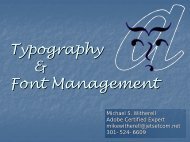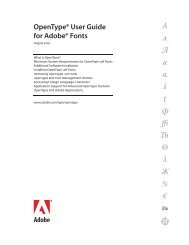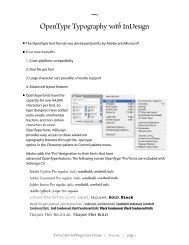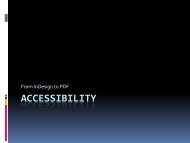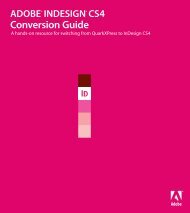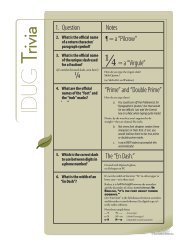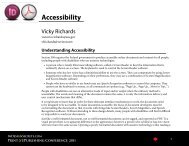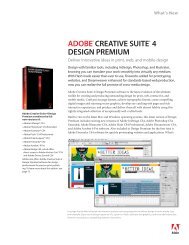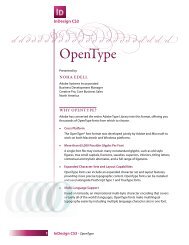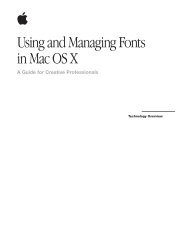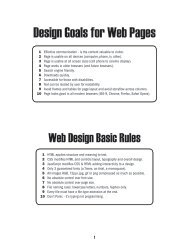Quark to InDesignCS3 Conversion Guide - InDesign User Group
Quark to InDesignCS3 Conversion Guide - InDesign User Group
Quark to InDesignCS3 Conversion Guide - InDesign User Group
Create successful ePaper yourself
Turn your PDF publications into a flip-book with our unique Google optimized e-Paper software.
• <strong>InDesign</strong> offers 10 built-in page<br />
sizes, including Letter-Half, Legal-<br />
Half, A3, A5, and Compact Disc.<br />
• The maximum size of an <strong>InDesign</strong><br />
page is 216" x 216" (that’s 18' x 18',<br />
compared <strong>to</strong> 48" x 48" or 4' x 4' in<br />
<strong>Quark</strong>XPress).<br />
• You can specify the number of<br />
pages (up <strong>to</strong> 9,999).<br />
• In <strong>InDesign</strong>, the Master Text<br />
Frame check box in the New<br />
Document dialog box is analogous<br />
<strong>to</strong> the Au<strong>to</strong>matic Text Box option<br />
in the <strong>Quark</strong>XPress New Project<br />
dialog box.<br />
• Clicking More Options in the New<br />
Document dialog box displays<br />
controls for creating bleed and<br />
slug areas. The bleed area is used<br />
for objects that you want <strong>to</strong> extend<br />
all the way <strong>to</strong> the trimline of the<br />
printed document. The slug area is<br />
the ability <strong>to</strong> snap objects <strong>to</strong> gridlines<br />
and guidelines makes it easy <strong>to</strong> align<br />
objects when you’re laying out pages.<br />
used for instructions <strong>to</strong> the printer,<br />
sign-off forms, or other information<br />
related <strong>to</strong> a document.<br />
• If you change your mind about<br />
document settings as you work,<br />
you can use the Document Setup<br />
dialog box (File > Document<br />
Setup) <strong>to</strong> change the page size and<br />
number of pages, as well as switch<br />
a facing-page document in<strong>to</strong> a<br />
non-facing-page document or<br />
vice versa. To change the settings<br />
you made for margins and<br />
columns in the New Document<br />
dialog box, select the document’s<br />
master pages in the Pages panel<br />
(Window > Pages), choose Lay-<br />
out > Margins And Columns,<br />
and make your changes.<br />
what gridlines and guidelines does<br />
<strong>InDesign</strong> offer?<br />
<strong>InDesign</strong> lets you create two kinds<br />
of nonprinting grids—a document<br />
grid and a baseline grid—as well as<br />
ruler guides and page guides. Also,<br />
you can create two kinds of baseline<br />
grids: document-wide baseline grids<br />
and text-frame-specific baseline<br />
grids. Here are brief descriptions of<br />
the kinds of gridlines and guidelines<br />
you can create with <strong>InDesign</strong>:<br />
Document grids. A document grid<br />
looks like graph paper and is useful<br />
for aligning objects. To create a<br />
document grid, choose <strong>InDesign</strong> ><br />
Preferences > Grids in Mac OS<br />
or Edit > Preferences > Grids in<br />
Windows. In the Document Grid<br />
area of the Grids pane, choose a grid<br />
color, and specify grid attributes<br />
by entering values for the Horizontal<br />
and Vertical options. To show a<br />
document grid, choose View > Grids<br />
& <strong>Guide</strong>s > Show Document Grid.<br />
Setting up Documents, Pages, and Master Pages 19






